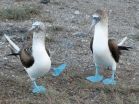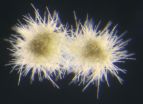(Press-News.org) From AGU's blogs: Volcanic soundscapes reveal differences in undersea eruptions
New research matching different types of underwater volcanic eruptions with their unique sound signatures could help scientists better detect and understand emissions occurring on the seafloor.
From Eos.org: Is the Shale Boom Reversing Progress in Curbing Ozone Pollution?
Concentrations of volatile organic compounds--precursors to ground-level ozone formation--are on the rise in areas over and downwind of a major shale oil and gas field in Texas.
From AGU's journals: When the Sun Goes Quiet, Titan Gets Gassy
Saturn's moon Titan is the only moon in the solar system that has an atmosphere as thick as Earth's, consisting of more than 98 percent nitrogen, roughly 1.4 percent of methane, and smaller amounts of other gases. NASA's Cassini satellite has been circling Saturn since 2004, witnessing more than one-third of its 29-year orbit around the Sun, allowing it to observe the changing of the seasons. However, a new study finds that the seasons are not the only thing changing Titan's atmosphere: its chemical makeup fluctuates according to the Sun's 11-year cycle of magnetic activity.
Westlake et al. analyzed data from 41 flybys of Titan, some at altitudes of less than 1000 kilometers (621 miles) when Cassini dipped into the upper fringes of its atmosphere. The authors found that the amount of methane there varied wildly over time-- it dipped from mid-2006 to 2008, then gradually recovered for two years, but crashed to roughly half of its 2006 peak by 2011.
These fluctuations correspond neatly to the 11-year solar cycle, in which the Sun's rotation gradually winds up its magnetic field into contorted coils, giving rise to flares and sunspots that emit ultraviolet and X-ray light. Upon reaching Titan, this powerful radiation can tear methane molecules apart.
After reviewing the Cassini data, the authors think that this destruction of methane occurred from 2006 to 2008 during the last phases of the previous solar maximum. Upon reaching solar minimum in 2008, the quiet Sun allowed Titan's methane to recover its levels. Then, as the Sun once again began gearing up toward its most recent solar maximum in 2013, methane levels declined. This case is bolstered by data from the last mission to make such measurements--the Voyager 1 spacecraft, which swooped by Titan in 1980 during solar maximum conditions and found similarly depleted levels of methane.
By using one- and three-dimensional models, the authors were also able to trace the movements of the different chemicals through Titan's atmosphere. During solar maximum, the broken-down methane remnants combine to form heavier hydrocarbons that rain down through the atmosphere. During solar minimum, the replenishment of methane in Titan's upper atmosphere comes from its lower layers. Although it takes only weeks for increased solar radiation to send Titan's methane levels crashing, it takes years for it to recover. The authors predict methane levels will not reach its previous peak until sometime this year.
Find more research spotlights from AGU journals and sign up for weekly E-Alerts, including research spotlights, on eos.org.
Read the online version of This Week From AGU and register for access to AGU journal papers in the AGU newsroom.
INFORMATION:
The American Geophysical Union is dedicated to advancing the Earth and space sciences for the benefit of humanity through its scholarly publications, conferences, and outreach programs. AGU is a not-for-profit, professional, scientific organization representing more than 60,000 members in 139 countries. Join our conversation on Facebook, Twitter, YouTube, and other social media channels.
How aware are you of the birds that live in your neighborhood? Do you know how many different species there are? Do enjoy your local birds, or find them annoying? J. Amy Belaire of St. Edward's University, Lynne Westphal of the U.S. Forest Service, and Emily Minor and Christopher Whelan of the University of Illinois at Chicago visited urban neighborhoods in the Chicago area to answer these questions and learn more about how people see their backyard birds. Their results, published in a new paper in The Condor: Ornithological Applications, provide a fascinating look at the ...
Life as a wild baby bird can involve a lot of stress; competing with your siblings, dealing with extreme weather, and going hungry due to habitat loss are just a few examples. However, birds have an amazing capacity to overcome stresses experienced early in life and go on to reproductive success as adults, according to a new Perspective paper in The Auk: Ornithological Advances by Hugh Drummond and Sergio Ancona of the Universidad Nacional Autónoma de México.
Some experiments with birds in captivity have found that increasing early-life stress through food deprivation, ...
TEMPE, Ariz. - As the search continues for Earth-size planets orbiting at just the right distance from their star, a region termed the habitable zone, the number of potentially life-supporting planets grows. In two decades we have progressed from having no extrasolar planets to having too many to search. Narrowing the list of hopefuls requires looking at extrasolar planets in a new way. Applying a nuanced approach that couples astronomy and geophysics, Arizona State University researchers report that from that long list we can cross off cosmic neighbor Tau Ceti.
The ...
Scientists have found something they can't quite explain in one of the most barren environments on Earth: a bacterium whose DNA sequence contains elements usually only found in a much higher organism.
Trichodesmium is a type of bacteria known as an oligotroph, meaning that it can survive in incredibly nutrient-poor regions of the ocean. In fact, it thrives there -- to the point that great blooms of the microorganism can be seen both with the naked eye and from satellites in space, earning it the name "sea sawdust" from ancient mariners.
This is because Trichodesmium ...
A new type of graphene aerogel will make for better energy storage, sensors, nanoelectronics, catalysis and separations.
Lawrence Livermore National Laboratory researchers have made graphene aerogel microlattices with an engineered architecture via a 3D printing technique known as direct ink writing. The research appears in the April 22 edition of the journal, Nature Communications.
The 3D printed graphene aerogels have high surface area, excellent electrical conductivity, are lightweight, have mechanical stiffness and exhibit supercompressibility (up to 90 percent ...
Montréal, April 22, 2015 - Researchers at the IRCM led by Artur Kania, PhD, uncovered the critical role in pain processing of a gene associated with a rare disease. Their breakthrough, published in The Journal of Neuroscience, paves the way for a better understanding of chronic pain conditions.
Dr. Kania's team studies the way neural circuits transform harmful stimuli (such as cold, heat, and pinch) into the perception of pain. More precisely, they examined the gene Lmx1b and its involvement in pain processing. Mutations in this gene also cause a rare human disease ...
PHILADELPHIA - In the first major study to examine the use of a computer-assisted, photo-driven differential diagnosis generator for skin conditions, researchers at the Perelman School of Medicine at the University of Pennsylvania found physicians routinely used the tool, without an increase in calling for inpatient dermatology consultations. The software diagnostic tool, VisualDx, aids in diagnosing dermatologic conditions by allowing physicians to enter information such as the type and location of a rash, and associated symptoms such as pain or itching, and then generating ...
SAN FRANCISCO--It may seem unlikely that a large earthquake would take place hundreds of kilometers away from a tectonic plate boundary, in areas with low levels of strain on the crust from tectonic motion. But major earthquakes such as the Mw 7.9 2008 Chengdu quake in China and New Zealand's 2011 Mw 6.3 quake have shown that large earthquakes do occur and can cause significant infrastructure damage and loss of life. So what should seismologists look for if they want to identify where an earthquake might happen despite the absence of historical seismic activity?
Roger ...
COLUMBUS, Ohio - Researchers have uncovered the first evidence of a genetic link between prodigy and autism.
The scientists found that child prodigies in their sample share some of the same genetic variations with people who have autism.
These shared genetic markers occur on chromosome 1, according to the researchers from The Ohio State University and Nationwide Children's Hospital in Columbus.
The findings confirm a hypothesis made by Joanne Ruthsatz, co-author of the study and assistant professor of psychology at Ohio State's Mansfield campus.
In a previous study, ...
WASHINGTON - Vehicle cost, current battery technology, and inadequate consumer knowledge are some of the barriers preventing widespread adoption of plug-in electric vehicles, says a new congressionally mandated report from the National Research Council. Developing less expensive, better performing batteries is essential to reducing overall vehicle cost, and a market strategy is needed to create awareness and overcome customer uncertainty. The report recommends a range of incentives that the federal government can offer to address these and other barriers.
The report ...



